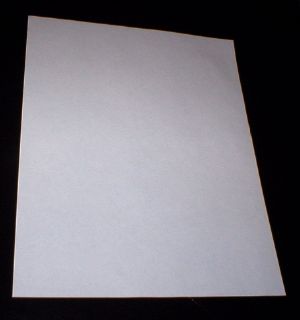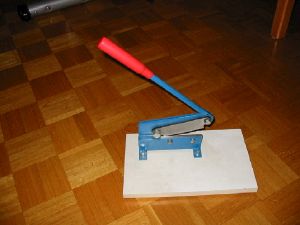Paper
Template:Alternateuses
Paper is a thin, flat material produced by the compression of fibres. The fibres used are usually natural and based upon cellulose. The most common material is wood pulp from pulpwood (largely softwood) trees such as spruces, but other vegetable fibre materials including cotton, linen, and hemp may be used. A stack of 500 sheets of paper is called a Ream. The edges of paper sheets can act as very thin, fine-toothed saws, leading to paper cuts.
Manufacture
Whether done by hand or with a Fourdrinier Machine, the paper making process has four simple steps:
Preparation of the fibres
The material to be used for making paper is first converted into pulp, a concentrated mixture of fibres suspended in liquid. As many of these fibres are derived from natural sources, this process often requires many stages of separation and washing. Once the fibres have been extracted, they may also be bleached or dyed to alter the appearance of the final product.
Forming into sheets
The pulp mixture is then further diluted with water resulting in a very thin slurry. This dilute slurry is drained through a fine-mesh moving screen to form a fibrous web. A watermark may be impressed into the paper at this stage of the process. This moving web is pressed and dried into a continuous sheet of paper.
In the case of the mould process, a quantity of the pulp is placed into a form, with a wire-mesh base (or other draining device), so that the fibres are left coated on the mesh and excess water can drain away. At this time, pressure may be applied to remove more water through a squeezing action. The paper may then be removed from the mould, wet or dry, and go on to further processing.
Most mass-produced paper is made using a continuous (Fourdrinier) process to form a reel or web. When dried, this continuous web may be cut into rectangular sheets by slitting the web vertically and then cutting it horizontally to the desired length. Standard sheet sizes are prescribed by governing bodies such as the International Organization for Standardization (ISO).
Drying
The paper may actually be dried several times during its manufacture. Dry paper is much stronger than wet, so it is best to keep the paper dry to prevent it breaking and stopping the production line (sometimes the paper does break in which case it is converted back into pulp and fed into the line).
Applications
- to write or print on: the piece of paper becomes a document; this may be for keeping a record (or in the case of printing from a computer or copying from another paper: an additional record) and for communication; see also reading. Also a paper may represent a value:
- paper money
- bank note
- check
- security
- voucher
- ticket
- In such cases making a copy that can not easily be distinguished from the original should be very difficult, to avoid abuse, see counterfeit.
- Official documents and private statements that are run through a computer are placed in individual letters by a "bursting machine" (right).
- Printed papers can be bound etc. to form a book, brochure, magazine, newspaper, etc.; a dysphemism for such an edition is "dead tree edition", as opposed to alternatives such as a file on hard disk (locally or accessed remotely through internet), CD-ROM, diskette, etc.
- A computer file can be converted to a paper document by printing, using a computer printer. The converse can be done by scanning, possibly followed by Optical character recognition (OCR).
- for packaging:
- envelope
- wrapping tissue
- wallpaper
- for cleaning (see also tissue, Kleenex):
- toilet paper
- handkerchiefs
- paper towels
- cat litter
- miscellaneous cleaning in the kitchen, etc.
- for construction
- papier-mâché
- origami
History
The word paper comes from ancient Egyptian writing material called papyrus, which was woven from papyrus plants. Papyrus was produced as early as 3000 B.C.E. Egypt, and then in ancient Greece and Rome. Further north, parchment or vellum, made of processed sheepskin or calfskin, replaced papyrus which requires subtropical conditions for growth. In China, documents were ordinarily written on bamboo, making them very heavy and awkward to transport. Silk was sometimes used, but was usually too expensive to consider. Most of the above materials were rare and costly.
The Chinese court official Cai Lun described the modern method of papermaking in AD 105; he was the first person who mentioned the method to make paper out of cotton rags. Other sources date back the invention of papermaking in China to 150 B.C.E. It spread slowly outside of China; other East Asian cultures, even after seeing paper, could not figure out how to make it themselves. Instruction in the manufacturing process was required, and the Chinese were reluctant to share their secrets. The technology was firstly transferred to Korea in 600 and then imported to Japan by Korean Buddhist priest, Dam Jing, in 625, where fibres (called bast) from the mulberry tree were used. After commercial trades and the defeat of the Chinese in the Battle of Talas, the invention spread to the Middle East, where it was adopted by the Indians and subsequently by the Italians in about the 13th century. They used hemp and linen rags.
Some historians speculate that paper was the key element in global cultural advancement. According to this theory, Chinese culture was less developed than the West's in ancient times because bamboo (although abundance of materials is generally the primary reason for the use of bamboo as opposed to scientific prowess) was a clumsier writing material than papyrus; Chinese culture advanced during the Han Dynasty and preceding centuries due to the invention of paper; and Europe advanced during the Renaissance due to the introduction of paper and the printing press.
Paper remained a luxury item through the centuries, until the advent of steam-driven paper making machines in the 19th century, which could make paper with fibres from wood pulp. Although older machines predated it, the Fourdrinier paper making machine became the basis for most modern papermaking. Together with the invention of the practical fountain pen and the mass produced pencil of the same period, and in conjunction with the advent of the steam driven rotary printing press, wood based paper caused a major transformation of the 19th century economy and society in industrialized countries. Before this era a book or a newspaper was a rare luxury object and illiteracy was the norm for the majority. With the gradual introduction of cheap paper, schoolbooks, fiction, non-fiction, and newspapers became slowly available to nearly all the members of an industrial society. Cheap wood based paper also meant that keeping personal diaries or writing letters ceased to be reserved to a privileged few in those same societies. The office worker or the white-collar worker was slowly born of this transformation, which can be considered as a part of the industrial revolution.
Unfortunately, the original wood-based paper was more acidic and more prone to disintegrate over time, a process known as slow fires. Documents written on more expensive rag paper were more stable. The majority of modern book publishers now use acid-free paper.
See also
- newspaper
- cardboard
- crêpe
- ISO 216
- newsprint
- paper sizes
- paper mill
- paper recycling
- pulp and paper industry
- stationery
- substrate (printing)
- washi
External links
- No End to Paperwork
- History of Paper and Papermaking
- Paper Online
- How Paper Is Made
- United States Government Printing Office: Government Paper Specification Standards
ar:ورق bg:Хартия ca:Paper cs:Papír da:Papir de:Papier als:Papier es:Papel eo:Papero fr:Papier gl:Papel ko:종이 id:Kertas is:Pappír it:Carta he:נייר lt:Popierius ms:Kertas nl:Papier ja:紙 no:Papir pl:Papier pt:Papel ru:Бумага simple:Paper sk:Papier sl:Papir fi:Paperi su:kertas sv:Papper th:กระดาษ vi:Giấy uk:Папір zh:纸

